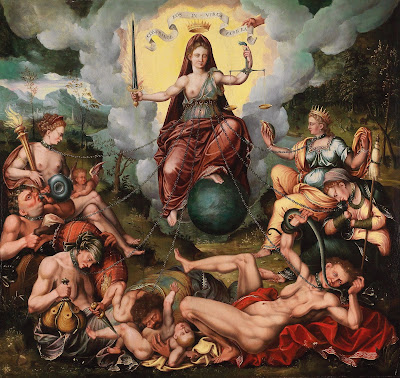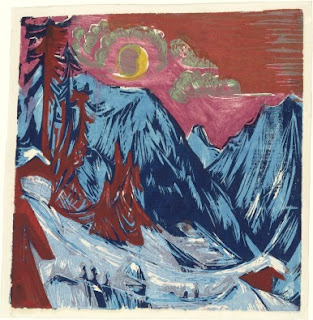First Ideas: Research
After some consideration I reduced my first ideas to two: The 7 deadly sins and Nature. Therefore I will do some research into these two concepts in order to choose one for my project which theme is Expressionism.
7 deadly sins
The seven deadly sins, also known as the seven capital sins or seven cardinal sins, were first enumerated in the 6th Century by Pope Gregory I (the Great) in his work 'Moralia in Job'. The seven deadly sins are : superbia (pride), avaritia (greed), luxuria (lust), invidia (envy), gula (gluttony), ira (wrath), and acedia (sloth).Each of these has an opposite among the corresponding seven holy virtues: chastity, abstinence, temperance, diligence, patience, kindness, and humility.
“All the seven deadly sins are peccadilloes but without three of them, Pride, Lust, and Sloth, poetry might never have been born." - Vladimir Nabokov, Pale Fire
The Chatolic Chruch distinguishes two different types of sin: venial sins, in which guilt is relatively minor, and the more severe mortal sins. According to the Church, a deadly sin threatens one with eternal damnation. Together wuth the Ten Commandments, it was one of the most discussed subjects of ethnics and examinations of conscience. There were many theological and confessional works structured arounf the this throughout the Middle Ages and Tridentine era.
In the official Catechism of the Catholic Church, consisting of 2,865 numbered sections and first published in 1992 by order of Pope John Paul II, the seven deadly sins are dealt with in only one paragraph. While no list of these seven deadly sins appears as such in the Bible itself, each of them is condemned at various points in the text.
A list of seven sins that God hates is found in Proverbs 6:16-19: There are six things the Lord hates, seven that are detestable to him: haughty eyes, a lying tongue, hands that shed innocent blood, a heart that devises wicked schemes, feet that are quick to rush into evil, a false witness who pours out lies and a man who stirs up dissension among brothers. (New International Version)
Nature
“The artist submits from day to day to the fatal rhythm of the impulses of the universal world which encloses him, continual centre of sensations, always pliant, hypnotized by the marvels of nature which he loves, he scrutinizes. His eyes, like his soul, are in perpetual communion with the most fortuitous of phenomena,” wrote French Symbolist painter, printmaker and pastelist Odilon Redon.
The relationship between humans and nature was probably thr first subject to appear in the history of art. Its graphic representations have appeared in the Palaelithic period and throughout history - nature has always been present as a preferential and referential theme in art.
During recent decades, there has been a transition in the representation of nature that, in many cases, is the result of a fusion of various intellectual, sociological, political and artistic ideas. Nature represented a healing escape from the crowds and anxiety of the city for the expressinoist artists - jarring colors and harsh angles take a backstage to blues, greens, and earthy colors.
After doing some research about both of concepts , I decided that I am going to choose "7 deadly sins" as concept for my project since I already have some ideas in mind and it was the one that I liked the most since the very beginning.
Reference:
Britannica, The seven deadly sins [online] Available from: https://www.britannica.com/topic/seven-deadly-sins (Accessed 16.01.2021)
Catholic Exchange (9 February 2006), Seven Capital Sins [online] Available from: https://catholicexchange.com/seven-capital-sins (Accessed 16.01.2021)
Florence Inferno (22 September 2014), The Seven deadly sins [online] Available from: https://www.florenceinferno.com/the-seven-deadly-sins/(Accessed 16.01.2021)
Susie Lewis (12 June 2015), RESEARCH – DANTE’S INFERNO AND THE SEVEN DEADLY SINS [online] Available from: https://susielewis.wordpress.com/2015/06/12/research-dantes-inferno-and-the-seven-deadly-sins/ (Accessed 16.01.2021)
MoMA, Expressionism [online] Available from : https://www.moma.org/learn/moma_learning/themes/expressionism/expressionism-and-nature/ (Accessed 16.01.2021)
NEO2 (8 April 2016), Art and Nature [online] Available from: https://www.neo2.com/art-and-nature/ (Accessed 16.01.2021)
Keystone (12 February 2019) Art and Nature - Finding your inspiration [online] Available from: https://www.bachelorstudies.com/article/art-and-nature-finding-your-inspiration/ (Accessed 16.01.2021)



Comments
Post a Comment